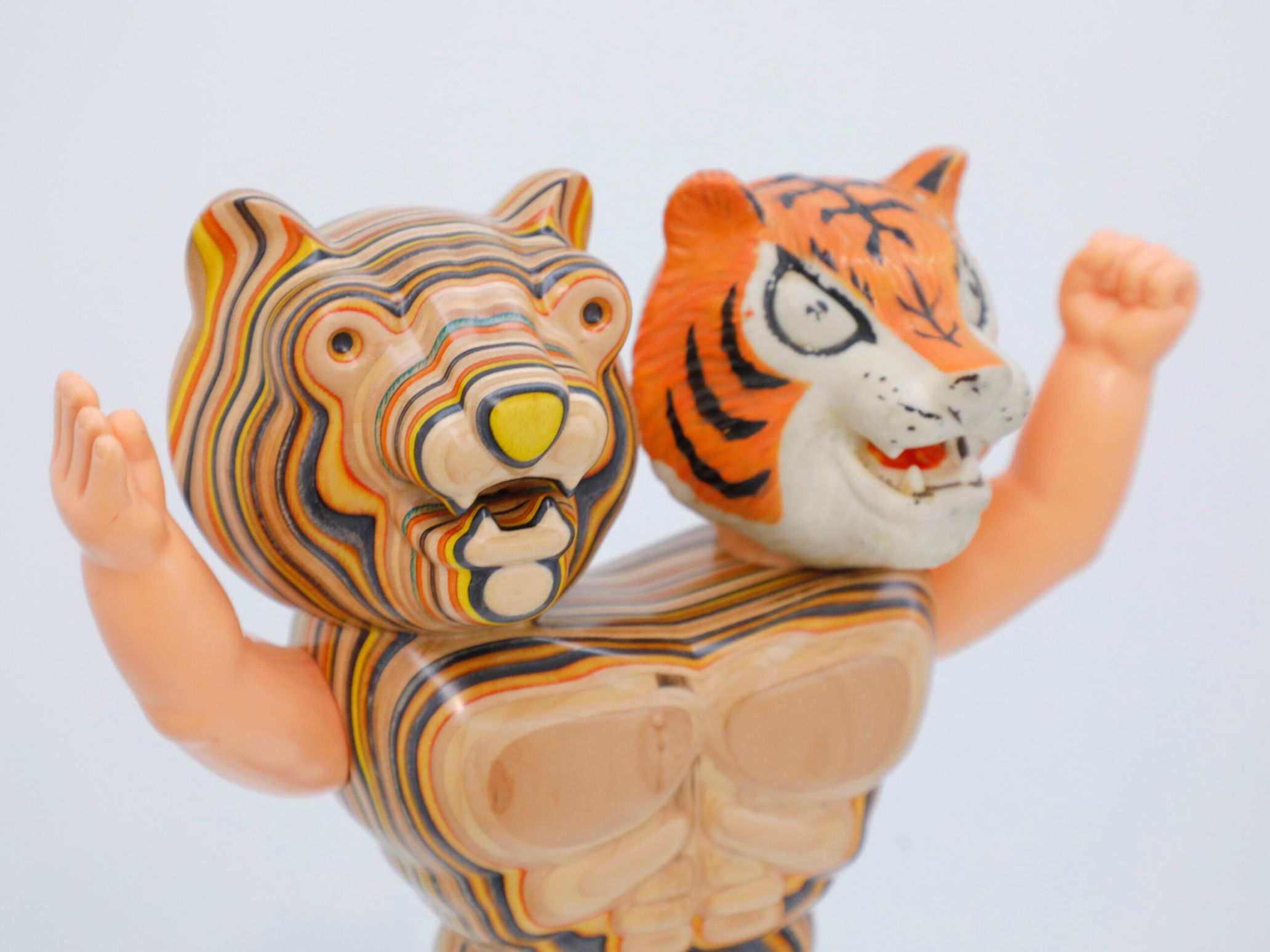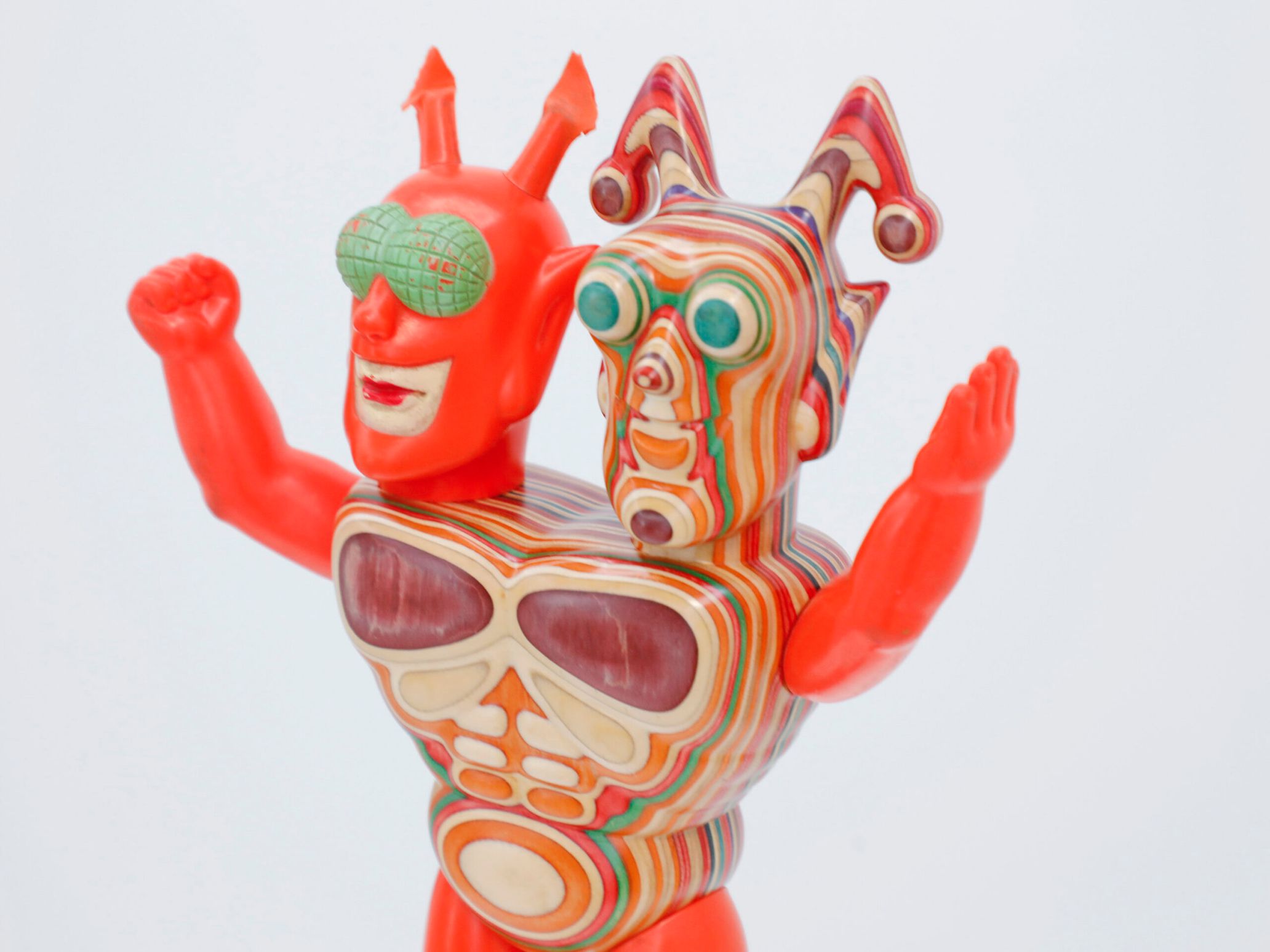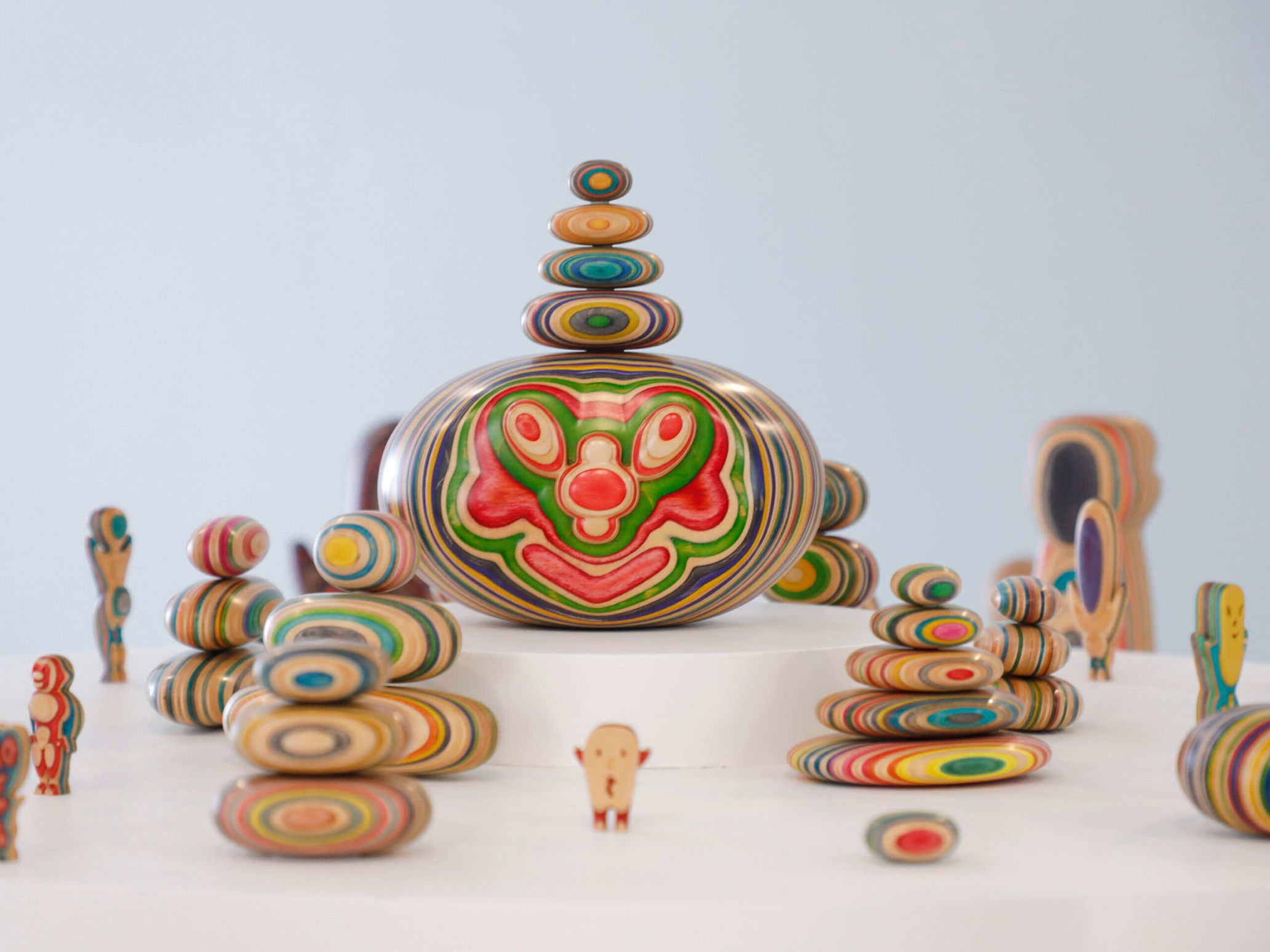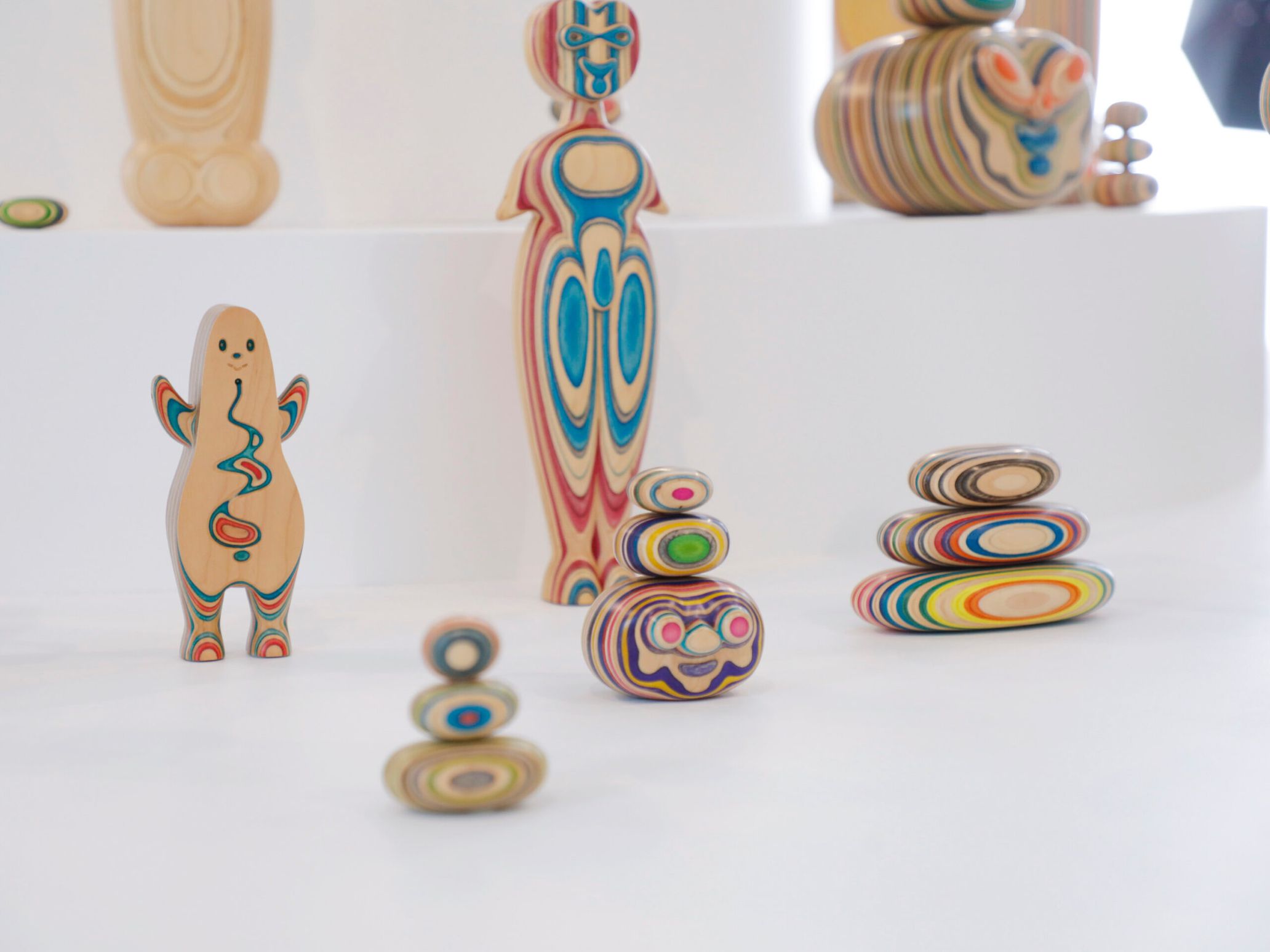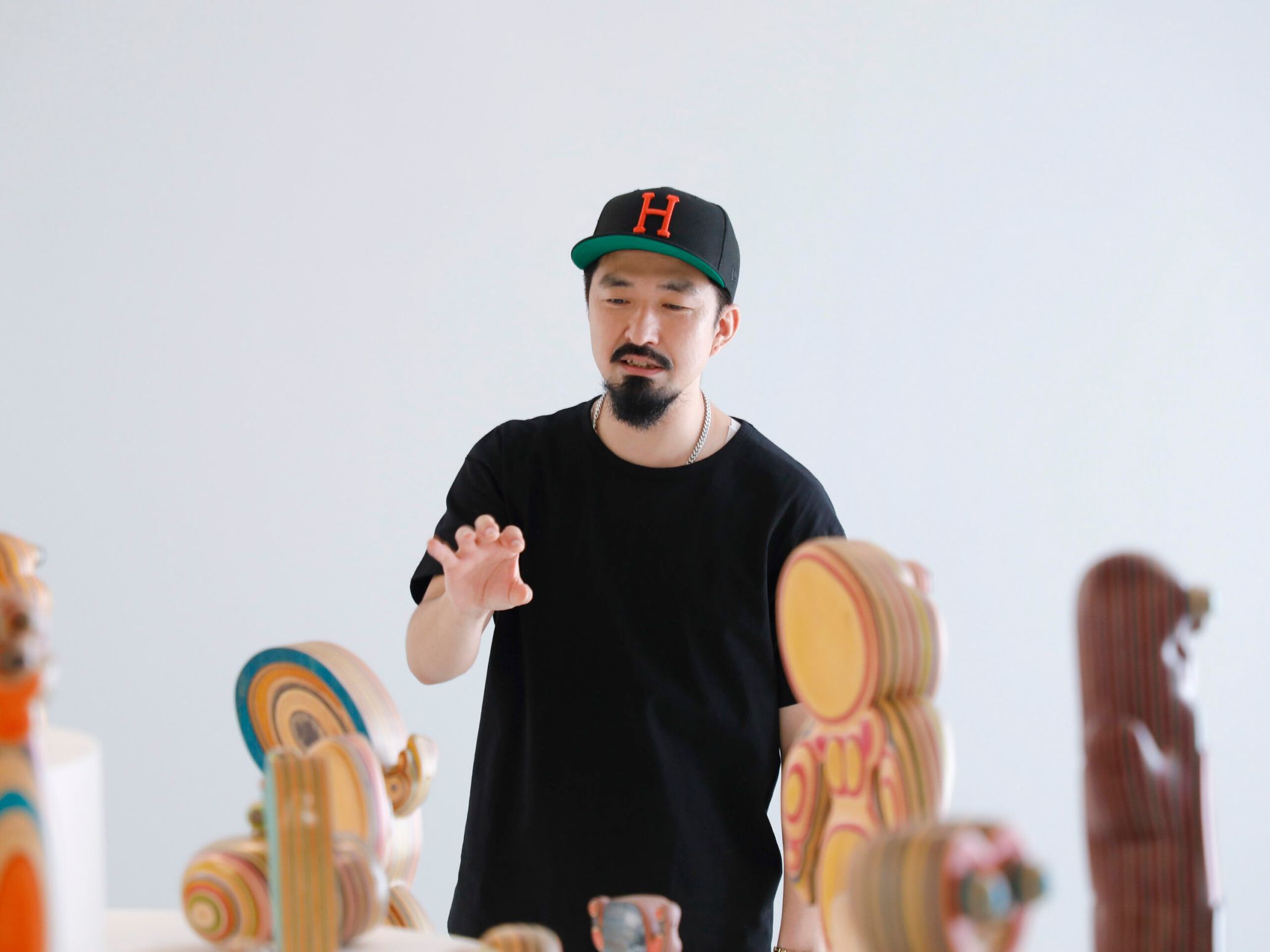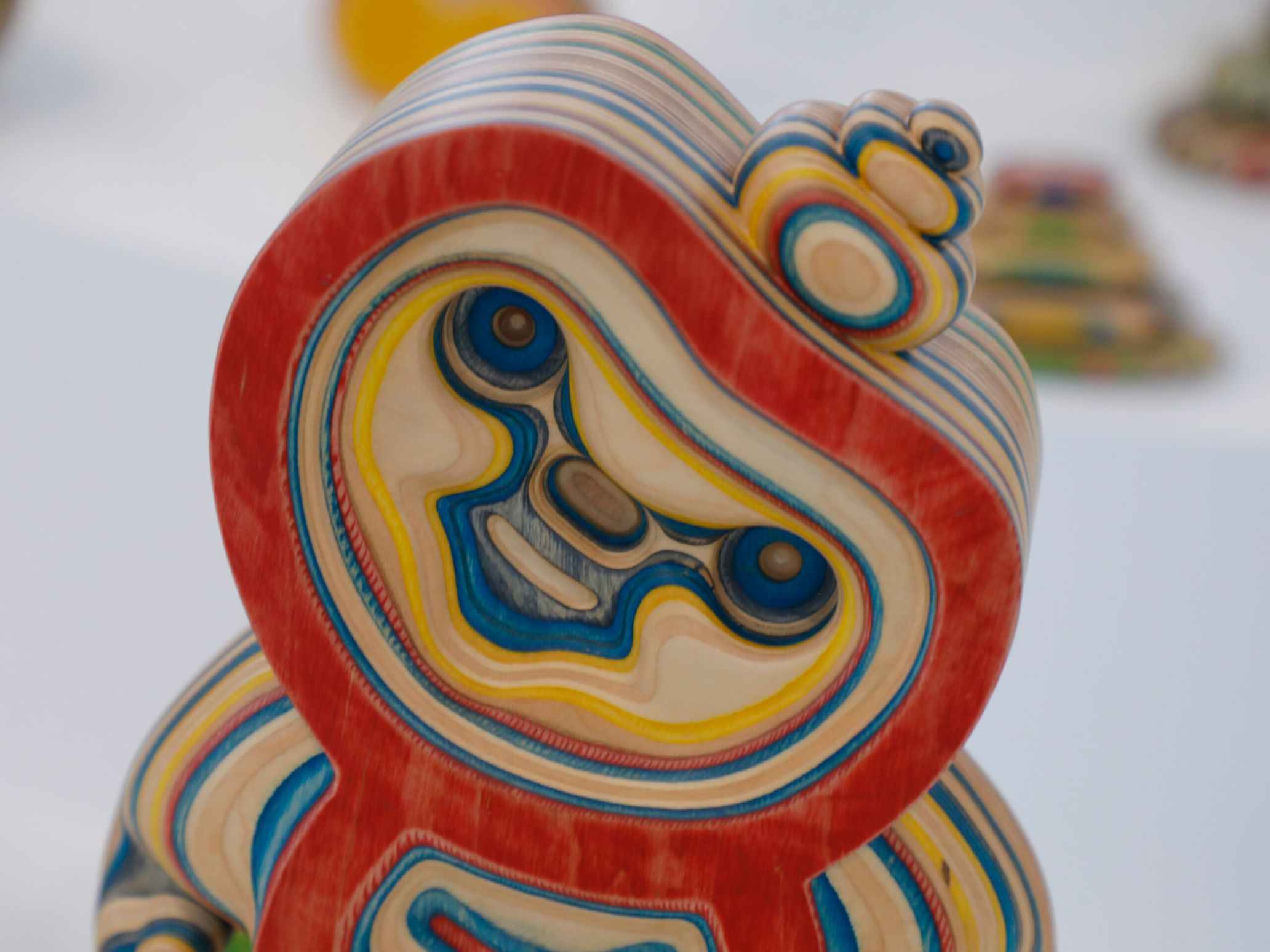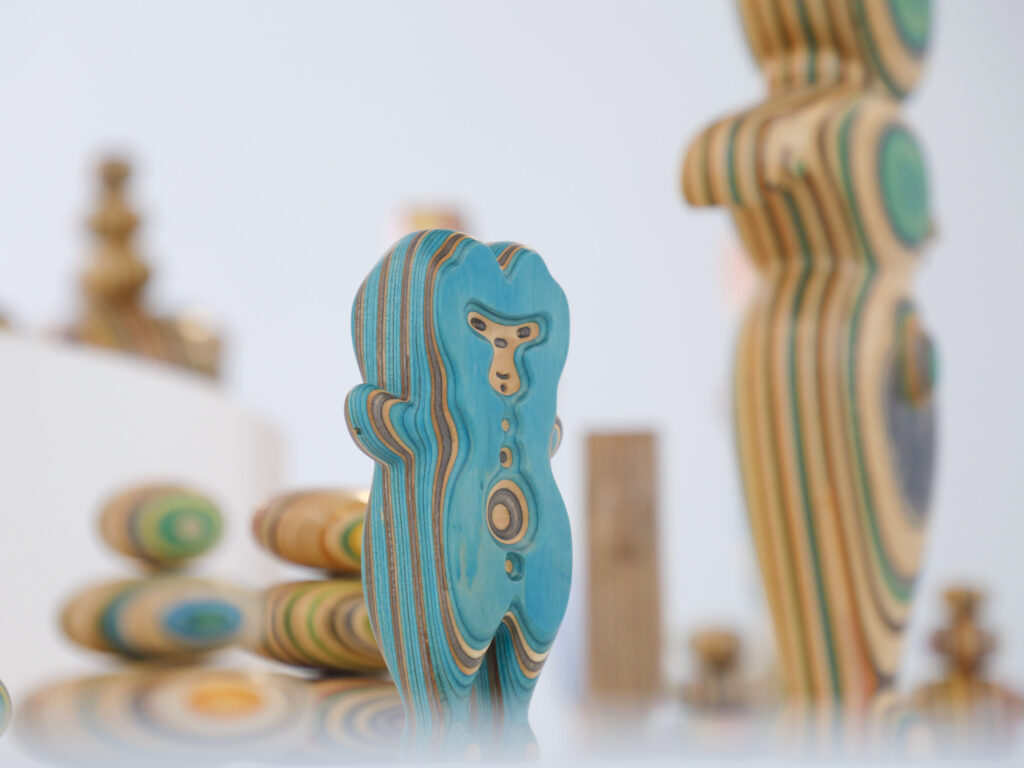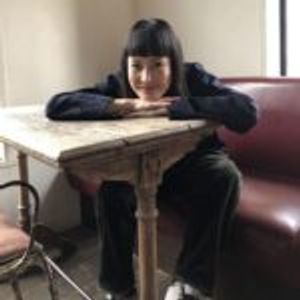Haroshi produces art using worn-out skateboard decks. The modern artist who is not only celebrated in the world of skateboarding, but well sought-after all around the world, had held his solo-exhibition, I versus I, at the gallery that newly opened this year, NANZUKA UNDERGROUND. His main artworks at the exhibition included sculptures crafted from piles of skate decks, “GUZO,” a slew of skate decks placed on a flat surface, “Mosh Pit,” and toys using sofubi (soft vinyl figures/figurines) of Date Naoto. The exhibition exuded his passion towards the cultures of custom-made, street, and skateboarding.
This interview was conducted in the beginning of summer during the exhibition period. The article is in two parts unveiling Haroshi’s stance on art.
In Part one, we talked about his solo-exhibition, I versus I, the reason why he decided to use figurines for his works, and his thoughts toward “GUZO.”
People around me were into sofubi and that led me to start the sofubi series
ーーHow did this exhibition come about?
Haroshi: When I did an exhibition at NANZUKA for the first time in 2017, we talked about what kind of exhibition we should do. Before that, when I did exhibitions in New York and other places abroad, I was only showing my favorite works. I’ve had specific requests from galleries before about the sizes of artworks—like some places wanted me to make enormous ones—but I’ve never discussed with them about motifs. Though with Japanese galleries, since we speak the same language, I can talk to them about a lot of things. So, it was great working with NANZUKA as I was able to ask for their opinions while working on the pieces; when I was seeking for ideas, they told me that they would be interested to see some human figured artworks, and so I started creating toys naming them “GUZO.”
That first exhibition at NANZUKA (Haroshi GOZU @Nanzuka Gallery) was in 2017, and a month later, I had another exhibition in London. I only had two months to prepare for the London gig and didn’t have enough artworks to fill up the gallery space. I was feeling stressed not knowing what to do, but right at that time, I found a cardboard box in a storage full of Naoto Date’s Tiger Masks that had lost their masks. It belonged to sofubi sculptor Mr. Kondo, who shared the same studio as me and worked in the room across from mine. I asked him if I could take some. I thought that if I only made the heads, I would be able to produce enough pieces for London in two months. So, I got many broken figurines from Mr. Kondo and made just the heads; that was the beginning of the sofubi series.
ーーWere you always into sofubi?
Haroshi: To be honest, I was never into sofubi before, but a lot of people around me were into it. My friend Pushead (Pus) who is an artist, introduced me to an English teacher as my English was so bad, and the teacher was a sofubi creator named Denis, who lives in Japan and owns a sofubi factory. So, whenever I had an English lesson on Skype, I see a large collection of sofubi arrayed behind the teacher. Every time during the lesson, he would point at one of his sofubi like, “what’s this?” And although I wasn’t that interested, he taught me many things about sofubi. [laughs]. Later, we started going to sofubi events together, like SUPER FESTIVAL where his works were exhibited, and my curiosity towards sofubi started growing as I began interacting more with him. Also at that time, Pus introduced me to sofubi sculptor Mr. Kondo, as I had to rent the whole studio by myself and was looking for someone to share the studio with me, and Mr. Kondo had also just lost his workplace and was having a hard time looking for a new place. So, I got Mr. Kondo to join the studio. And later, there were more people joining the studio who were all in the sofubi business—and so creating artworks with sofubi came about naturally for me.
Custom-made culture underlying in I versus I
ーーI thought you were into sofubi since you were little [laughs].
Haroshi: Of course, I’ve always liked sofubi, but I just never wanted to get in line to buy one. You always have to be in a line to get the best ones. I don’t have the grit to be in line to buy something. But since I started making sofubi myself, I go to auction sites and buy figurines, like Naoto Date figurines, that most people wouldn’t want to buy. Tiger Mask figures without the iconic mask are the most unwanted ones, so I buy whenever I find one. So, I have a same-faced Naoto Date squad at home [laughs]. It’s like how bikers customize choppers—customizing culture is about customizing the parts you don’t necessarily need to. And that same concept underlies in I versus I; I think making a main art piece from unwanted sofubi, like those Naoto Date ones, and putting a title to it is such a cool thing.
ーーI agree, that’s the cool part of the customizing culture.
Haroshi: I’m fond of vintage goods like vintage denims and bikes. They’re really cool but they’re originally from an exclusive market, where people were making unwanted items look cool. Like punks looked cool with their leather jackets customized with studs, but they were wearing them because leather jackets were the cheapest in London back then. For me, it’s exciting to find values in things that aren’t deemed valuable.
ーーSo, the idea of transforming used skateboards into modern art came about naturally to you.
Haroshi: That’s right. There’s a great balance in creating things out of what people throw away. The idea of Alchemy exists for a long time, which is a concept of producing money out of nothing, and I think the role of humans is to create values out of nothing. I enjoy making things with that concept in mind.
In my childhood, I stood out with my summer assignments
ーーAre you a self-taught artist?
Haroshi: I went to a jewelry art school and after I graduated, I immediately became an apprentice to a molding artist, but I’ve never studied woodwork or art in general. I’ve been crafting something since I was a kid, so I kind of knew how to craft things. When I was in elementary school, I made dolls or stuff that were hard to get from Kleenex. Back then, figurines of Kinnikuman (Muscle Man in English) were popular and the figurines of my favorite show, Sakigake!! Otokojuku were hard to find. So, I made them by myself…. They were poorly made, though.
ーーSo, does that mean you’ve been creating 3D artworks since then?
Haroshi: Yes. They weren’t cool as it sounds, though, since they were low in quality. I was a sickly kid, so I was in a hospital all the time. I wasn’t good with sports, but I got to shine the most with my summer assignments. My grandfather was really good at crafting things too and we were always keen for summer break to start—we would buy many supplies at Tokyu Hands and craft all sorts of things together. In the beginning of a new semester after summer break, I always stood out with my summer assignment.
ーーRegarding “GUZO,” would you say you had to plan precisely to create the series?
Haroshi: Well, you know… The first-ever figurine I created was made from a Mirror Man bootleg I bought at SUPER FESTIVAL, which was gigantic, but I liked the proportion of its body. Once you make one, you can get a grasp of how it’s made; I was able to create the second and the third one deciding the body proportions on my own. So, if you see the series in chronological order, you can tell the first one is very much a normal sofubi from the proportion of its body and head. NANKUZA took my first figurine to Art Barsel, and they told me that they earned many reactions from the attendees, so then I’ve decided to brush up the figurines for my solo exhibition.
GUZO was sculpted to greet Buddha
ーーIs there a certain motif you imagine when creating your works?
Haroshi: I don’t have a specific motif in mind and it’s different from creating normal sculptures as I go by the colors of the decks. When putting the decks together, I imagine making something in red if the top layer is red; the tone of the red changes as I carve deeper and I stop carving when I reach the ideal shade. Normally, sculpting is done by imagining the final shape you want to achieve, but for me, there’s no such thing as a right shape. I just stop carving when I get to the color tone I like, and that depends on my own discretion.
ーーIt’s interesting how the color tone changes as you carve deeper. So, you’re adjusting with your aesthetic decisions and instincts.
Haroshi: There’s a saying for Busshi (Buddhist sculptors): “Greeting the Buddha.” They carve out Buddhist statues out of wood, but they make sure that they don’t hurt the Buddha. Basically, they believe that there’s Buddha living inside wood, and their job is to carve them out in perfect shape. If they carve too much, they will hurt the Buddha, and if they don’t carve enough, that means they fail to greet the Buddha. It’s the same for me with “GUZO”; I’m greeting “GUZO” by carving them out of a pile of skate decks. I’ll hurt them if I carve too much, so it’s like finding a good balance and letting them come out of me.
ーーAnd where did you find out about the story you just mentioned about the Busshi?
Haroshi: I just like Busshi-related stories in general. Since I didn’t go to college, I’ve been trying to see and learn as many different things as possible. There’s an art professor named Mr. Satoshi Yabuuchi, who sculps and fixes Buddhist statues. He also writes many books, and I’ve learned about Busshi and their philosophy through his books.
ーーYou never know how the sculptures are going to look like in the end…Each work is absolutely an one-and-only thing.
Haroshi: It’s like expressing what I feel as I carve; if I determine a goal of what I want to create in the beginning, it’s going to turn into something ordinary. Plus, it usually doesn’t turn out the way I imagine. Like, it never works out following a blueprint. I think it’s better to be flexible with these kinds of things. So, I just go with the flow.
ーーIs there something you would like to create with the same way you produce “GUZO”?
Haroshi: I think I can make pretty much anything I want. I try not to decide what character I want to create or how I should create something, because I don’t want to create just one thing in specific. Of course, there’s a lot I want to create. I usually go on live when I’m making whatever I want. Not that they are all good in quality and worth presenting to the world. As a hobby, I like to make wooden bear sculptures. However, they don’t look right for my exhibitions, so I just keep them at home.
※Continues to the Part.2
Haroshi
Born in 1978 in Tokyo. He started skateboarding in 1993. After cutting his teeth in jewelry production, he launched Haroshi with his partner in 2003. He produces sculptures and installations using discarded skateboard decks. He is based in Downtown Tokyo, though his works are praised all over the world. In the past, he collaborated with the skateboard brand, HUF, produced BATB (Battle At The Berrics) trophies, opened his solo-exhibition at Nova sector in 2018 Art Basel Miami Beach, and from 2019 to 2020, his works were exhibited at Jeffrey Deitch’s Tokyo Pop Underground, which took place in New York and Los Angeles. He just released his art book HAROSHI (2003 – 2021), which documents 18 years of his career and artworks.
Instagram:@haroshi
Photography Shinpo Kimura
Translation Ai Kaneda


